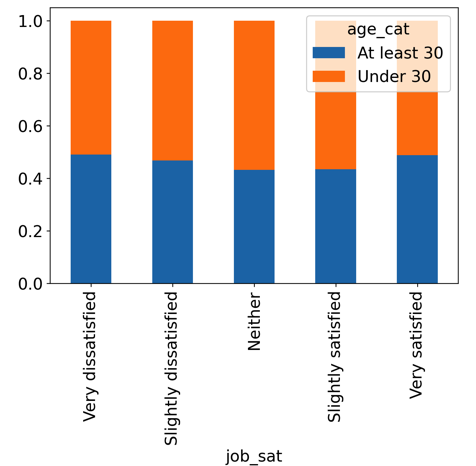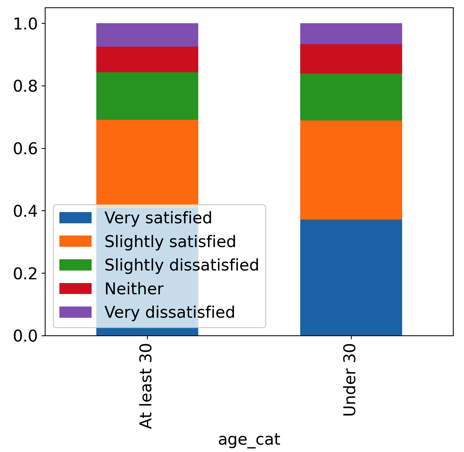Chi-square test of independence
Hypothesis Testing in Python

James Chapman
Curriculum Manager, DataCamp
Revisiting the proportion test
age_by_hobbyist = stack_overflow.groupby("age_cat")['hobbyist'].value_counts()
age_cat hobbyist
At least 30 Yes 812
No 238
Under 30 Yes 1021
No 190
Name: hobbyist, dtype: int64
from statsmodels.stats.proportion import proportions_ztest
n_hobbyists = np.array([812, 1021])
n_rows = np.array([812 + 238, 1021 + 190])
stat, p_value = proportions_ztest(count=n_hobbyists, nobs=n_rows,
alternative="two-sided")
(-4.223691463320559, 2.403330142685068e-05)
Independence of variables
Previous hypothesis test result: evidence that hobbyistand age_cat are associated
Statistical independence - proportion of successes in the response variable is the same across all categories of the explanatory variable
Test for independence of variables
import pingouin
expected, observed, stats = pingouin.chi2_independence(data=stack_overflow, x='hobbyist',
y='age_cat', correction=False)
print(stats)
test lambda chi2 dof pval cramer power
0 pearson 1.000000 17.839570 1.0 0.000024 0.088826 0.988205
1 cressie-read 0.666667 17.818114 1.0 0.000024 0.088773 0.988126
2 log-likelihood 0.000000 17.802653 1.0 0.000025 0.088734 0.988069
3 freeman-tukey -0.500000 17.815060 1.0 0.000024 0.088765 0.988115
4 mod-log-likelihood -1.000000 17.848099 1.0 0.000024 0.088848 0.988236
5 neyman -2.000000 17.976656 1.0 0.000022 0.089167 0.988694
$\chi^2$ statistic = 17.839570 = $(-4.223691463320559)^2$ = ($z$-score)$^2$
Job satisfaction and age category
stack_overflow['age_cat'].value_counts()
Under 30 1211
At least 30 1050
Name: age_cat, dtype: int64
stack_overflow['job_sat'].value_counts()
Very satisfied 879
Slightly satisfied 680
Slightly dissatisfied 342
Neither 201
Very dissatisfied 159
Name: job_sat, dtype: int64
Declaring the hypotheses
$H_{0}$: Age categories are independent of job satisfaction levels
$H_{A}$: Age categories are not independent of job satisfaction levels
alpha = 0.1
- Test statistic denoted $\chi^{2}$
- Assuming independence, how far away are the observed results from the expected values?
Exploratory visualization: proportional stacked bar plot
props = stack_overflow.groupby('job_sat')['age_cat'].value_counts(normalize=True)wide_props = props.unstack()wide_props.plot(kind="bar", stacked=True)
Exploratory visualization: proportional stacked bar plot

Chi-square independence test
import pingouin
expected, observed, stats = pingouin.chi2_independence(data=stack_overflow, x="job_sat", y="age_cat")
print(stats)
test lambda chi2 dof pval cramer power
0 pearson 1.000000 5.552373 4.0 0.235164 0.049555 0.437417
1 cressie-read 0.666667 5.554106 4.0 0.235014 0.049563 0.437545
2 log-likelihood 0.000000 5.558529 4.0 0.234632 0.049583 0.437871
3 freeman-tukey -0.500000 5.562688 4.0 0.234274 0.049601 0.438178
4 mod-log-likelihood -1.000000 5.567570 4.0 0.233854 0.049623 0.438538
5 neyman -2.000000 5.579519 4.0 0.232828 0.049676 0.439419
Degrees of freedom:
$(\text{No. of response categories} - 1) \times (\text{No. of explanatory categories} - 1)$
$(2 - 1) * (5 - 1) = 4$
Swapping the variables?
props = stack_overflow.groupby('age_cat')['job_sat'].value_counts(normalize=True)
wide_props = props.unstack()
wide_props.plot(kind="bar", stacked=True)
Swapping the variables?

chi-square both ways
expected, observed, stats = pingouin.chi2_independence(data=stack_overflow, x="age_cat", y="job_sat")
print(stats[stats['test'] == 'pearson'])
test lambda chi2 dof pval cramer power
0 pearson 1.0 5.552373 4.0 0.235164 0.049555 0.437417
Ask: Are the variables X and Y independent?
Not: Is variable X independent from variable Y?
What about direction and tails?
- Observed and expected counts squared must be non-negative
- chi-square tests are almost always right-tailed $^{1}$
1 Left-tailed chi-square tests are used in statistical forensics to detect if a fit is suspiciously good because the data was fabricated. Chi-square tests of variance can be two-tailed. These are niche uses, though.
Let's practice!
Hypothesis Testing in Python

